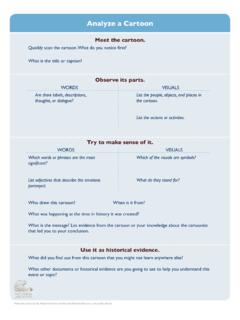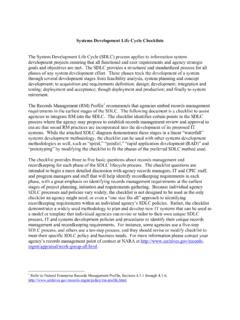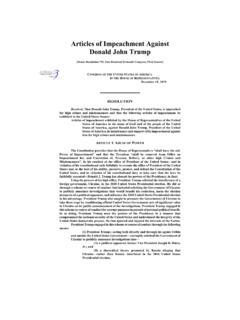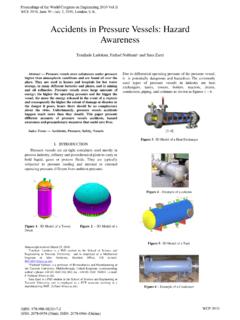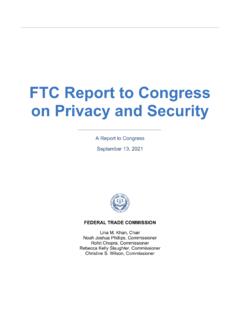Transcription of Congress at Work—The Presidential Veto and Congressional ...
1 The Presidential Veto and Congressional Veto Override Process Center for Legislative Archives National Archives and Records Administration Background information on the veto process for the teacher: While the word veto does not appear in the Constitution, the power of the President to refuse to sign legislation is clearly outlined in the Constitution: Every Bill which shall have passed the House of Representatives and the Senate, shall, before it become a Law, be presented to the President of the United States: If he approve he shall sign it, but if not he shall return it, with his Objections to that House in which it shall have originated, who shall enter the Objections at large on their Journal, and proceed to reconsider it.
2 If after such Reconsideration two thirds of that House shall agree to pass the Bill, it shall be sent, together with the Objections, to the other House, by which it shall likewise be reconsidered, and if approved by two thirds of that House, it shall become a Law. Constitution, Article I, Section 7, clause 2 The Framers of the Constitution gave the President the power to veto acts of Congress to prevent the legislative branch from becoming too powerful. This is an illustration of the separation of powers integral to the Constitution.
3 By separating the powers of government into three branches and creating a system of checks and balances between them, the Framers hoped to prevent the misuse or abuse of power. The veto allows the President to check the legislature by reviewing acts passed by Congress and blocking measures he finds unconstitutional, unjust, or unwise. Congress s power to override the President s veto forms a balance between the branches on the lawmaking power. The veto power does not give the President the power to amend or alter the content of legislation the President only has the ability to accept or reject an entire act passed by Congress .
4 The President, however, can influence and shape legislation by a threat of a veto. By threatening a veto, the President can persuade legislators to alter the content of the bill to be more acceptable to the President. Congress can override a veto by passing the act by a two-thirds vote in both the House and the Senate. (Usually an act is passed with a simple majority.) This check prevents the President from blocking an act when significant support for it exists. Two-thirds is a high standard to meet broad support for an act is needed to reach this threshold.
5 The President s veto power is significant because Congress rarely overrides vetoes out of 1,484 regular vetoes since 1789, only , or 106, have been If the President does not sign the bill within ten days it becomes law unless Congress has adjourned. If Congress adjourns before the President has signed the bill and the President does not want the bill to pass the President may simply fail to sign the bill. When this happens the bill does not become law (it is essentially vetoed). This is referred to as a pocket veto.
6 Since 1 Congressional Research Service. The Presidential Veto and Congressional Procedure (RS21750; February 27, 2004), by Mitchel A. Sollenberger, 2. The Presidential Veto and Congressional Veto Override Process Center for Legislative Archives National Archives and Records Administration Congress cannot vote while in adjournment a pocket veto cannot be overridden. 42% of all Presidential vetoes from 1789-2004 have been pocket A Close Look at the Documents Students can use a veto message and vetoed bill to make a direct connection between the Constitution, the legislative and veto process, and the separation of powers between the legislative and executive branches of government.
7 A facsimile of a 1973 President Richard Nixon veto and the vetoed bill (S. 518) provides students with the opportunity to walk through the Constitution s veto clauses and gain a greater understanding of the veto process. Every Bill which shall have passed the House of Representatives and the Senate, shall, before it become a Law, be presented to the President of the United An examination of this act shows Congress passed it and both the Speaker of the House of Representatives, Carl Albert, and the Acting President Pro Tempore of the Senate, Robert Byrd, signed it.
8 The date of passage of is not listed but a stamp near the top left of the document indicates that the act was presented to the President at the White House on May 7, 1973..If he approve he shall sign it, but if not he shall return it, with his Objections to that House in which it shall have Had President Nixon approved this act he would have signed and dated it below the signatures of the Speaker and Acting Senate President Pro Tempore. President Nixon, however, did not approve the act and returned it with his objections to Congress .
9 To determine whether he should send his message to the House or Senate he would look to the top left corner of the act. In this document S. 518 is printed above the red line, which indicates the bill number the number the bill was given when it was first introduced into Congress . The S. reveals that the bill was introduced in the Senate. Bills originating in the House of Representatives begin with Bill numbers are assigned serially, therefore this bill was the 518th bill introduced in the Senate in the 93rd Congress .
10 Since the bill originated in the Senate, Nixon s veto message is addressed to The Senate of the United States. The two page veto message, dated May 18, 1973, outlines his objections. This date indicates that Nixon complied with the Constitutional mandate that he respond within ten Days (Sundays excepted) after it shall have been presented to him (Article I, section 7, clause 2)..who to reconsider When a vetoed bill is returned to Congress it becomes a question of high privilege and all pending business may be set aside to allow Congress to immediately reconsider the vetoed bill.


